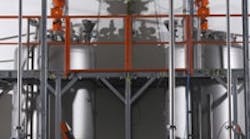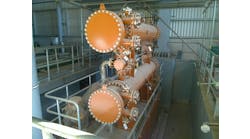Chemical processors often view cleaning of tanks and totes as a necessary but costly and headache-ridden burden. Tank cleaning requires a significant amount of resources to ensure a quality, uncontaminated next batch. In addition, inefficient tank cleaning when your clean-in-place (CIP) device isn’t working properly, cleaning well enough, or is out for maintenance or repair can cause production to come to a halt. Yet, despite the adverse effect on the bottom line, many manufacturers continue to rely on outdated procedures for cleaning, missing the opportunity for substantial cost reductions and revenue recovery through CIP optimization.
Figure 1. A rotary impingement machine provides precise, repeatable and comprehensive scouring of vessel in
Understanding how to optimize a cleaning process requires a grasp of the basics of cleaning. Herbert Sinner, a former chemical engineer for Henkel, first summarized the basic principles of cleaning in 1959. His summary, now referred to as the “Sinner’s Circle,” describes the four factors that can be manipulated in any cleaning scenario: temperature, chemical action, time and mechanical force.Increasing the effectiveness of any factor will result in a decrease of one or more other factors. Dishwashing provides a good example of how the four factors interact. Hot water (temperature) will remove stuck-on food better than cold water. Adding soap (chemical action) makes the process even easier, and you either can soak a dish overnight (time) or scrub it clean (mechanical force). It’s imperative to examine the effectiveness and efficiency of your procedure — and then to apply the Sinner’s Circle to compare CIP options. The most-common cleaning practices are: “boiling out” or “fill and drain,” manual cleaning, wetting (static spray balls), rotary wetting (rotary spray balls) and rotary impingement cleaning. Boiling-out or fill-and-drain methods involve filling tanks with hot water and caustic. These procedures are time-consuming and use lots of water and chemicals, which is a large concern due to sustainability goals and the expense of disposal.In manual cleaning, people remove residue by scrubbing, scraping or other means. Although companies have automated nearly every other process, many still rely on manual cleaning not only to clean but also to validate the cleaning process. However, human error may occur, and manual cleans never are identical. In addition, the procedure may subject employees to toxic fumes or dangerous materials in a vessel and pose risks from confined space entry. Moreover, the potential damage to the tank is high. Static spray balls and rotary spray heads rely on small orifices or narrow passages to distribute the wash fluid. The water and chemicals typically are split four or more ways, depending upon the manufacturer. These devices can be positioned at any angle inside a tank and can wet a tank quickly. For easy-to-clean residues such as powders or dry materials, spray balls and spray heads can be a suitable option. If quick dispersion is needed to coat a tank rapidly with a chemical or disinfectant, or if water usage isn’t an issue, a spray ball may be a good choice. Opt for a rotary spray head if the cascading cleaning effect provides a sufficient clean. Rotary impingement machines combine pressure and flow to create high-impact cleaning jets. Cleaning occurs at the point the concentrated stream impacts the surface. The impingement force is distributed in a precise, repeatable and reliable 360° pattern (Figure 1); this full-coverage, indexing pattern ensures the entire interior is cleaned every time. The impacts and resulting tangential force radiating from the points blast contaminants from the surface, scouring 100% of the tank interior. This reduces the time and temperature required, and can cut water and chemicals usage by up to 80%. SUCCESSFUL APPLICATIONSA major chemical company was using a fill-and-drain method that was taking too long to clean. Moreover, water usage was a major concern because of drought conditions. The total process consumed 5,800 gallons of water with a caustic concentrate per batch, which amounted to 1.5 million gallons per year. The company switched to a rotary impingement device to deliver hot water and caustic. It thoroughly cleaned the tank — including shadow areas due to internal obstructions — with only a 12-minute wash time. Not only was the cleaning 94% faster but the company also achieved its goal of reducing water and chemical usage by 95%. Another chemical manufacturer couldn’t meet customer demand because of the downtime incurred for cleaning its tanks with spray balls. The tanks were shut down every day for cleaning. This took a minimum of one hour but often longer because of the frequent clogging of the spray balls and the need for manual cleaning when the spray balls would fail. The company turned to rotary impingement tank cleaners and was able to clean 91% faster, which allowed a 71% increase in production.A third chemical producer was concerned not only about the time and money it spent on manual cleaning but also about validating the cleaning process and employee safety. The manual cleaning procedure took 2 hours per day and included confined space entry, scraping and scrubbing. Moreover, it consumed a significant amount of water — millions of gallons of water per year, which cost the company $16,000. After switching to a rotary impingement device, total cleaning time per tank dropped to only 20 minutes. The automated machine gives this facility a repeatable and reliable cleaning pattern, allows it to meet U.S. Occupational Safety and Health Administration requirements by eliminating confined space entry, and saves $11,000 per year. TOTE CLEANINGMany plants use totes for storing and transporting materials. Improper or inefficient cleaning of totes directly impacts overall productivity. Traditionally, facilities have outsourced tote cleaning or paid a fee to return dirty totes to suppliers. However, rotary impingement tote cleaners enable cleaning to be done on site in 2–7 minutes, cutting costs and improving productivity, as one chemical company can testify. That company ships its products in totes; after the products have been delivered, the totes are returned for re-use. It also re-uses many of the totes it gets from suppliers of raw materials. The director of operations was frustrated by the time, inconsistency and costs of sending dirty totes to a vendor for refurbishing/cleaning. He also had to make sure that re-used totes were 100% clean to avoid the dangers of cross-contamination between product shipments. This often necessitated manual cleaning on site — but the results were less than perfect. So, he purchased a rotary impingement machine. It reduced the time spent cleaning totes on site and increased the level of cleaning effectiveness. As a result, the company spent 50% less time cleaning while eliminating outsourcing and achieving a consistent clean. The machine paid for itself in one week.MAKING THE RIGHT CHOICERotary impingement machines aren’t the answer for all tank-cleaning applications, though. For example, with relatively easy-to-clean residues such as powders, the devices can be overkill for the job — providing more water-jet impact than necessary to effectively clean — and for the budget. Whereas a spray ball or rotary spray head typically costs under $1,000, rotary impingement machines generally run $3,000–$5,000. Just as with any purchase, conduct a return-on-investment (ROI) analysis to determine the payback of a rotary impingement machine versus a spray ball or rotary spray head. If the payback on a rotary impingement device exceeds 5 years, then opt for a spray ball or rotary spray head. An easier test is to ask yourself a simple question: Is this spray ball getting my tanks clean, quickly and effectively? If the answer is yes, then stick with the spray ball. If not, then it may be time to upgrade to the higher water-jet impact offered by rotary impingement cleaning.If quick dispersion is needed to coat a tank rapidly with a chemical or disinfectant, don’t consider rotary impingement machines. At this time, they don’t have the capability for quick dispersion.Also, at sites where water is abundant and cheap and, thus, where reducing water use isn’t a top priority, the savings provided by a rotary impingement machine may not be as compelling as elsewhere. It’s also important to note that some rotary impingement machines can be damaged if operated at a pressure higher than that recommended by the manufacturer. Tank size, internal obstructions as well as the residue must be considered when selecting and sizing a machine. Also keep in mind that not all rotary cleaners are equally robust. Many “off-the-shelf” devices easily clog, break down and incur high repair costs; the result is inefficient cleaning and massive tank downtime. To make the most out of your CIP, your tank cleaning machine should be durable. Furthermore, maintenance and necessary repairs should be quick, easy and affordable. Tank and tote cleaning, when done properly, can save massive amounts of time and water. Audit your CIP to see what you can do to make your sustainability goals a reality. The right rotary impingement machine may provide significant benefits that directly impact the bottom line.ANDREW DELANEY is executive vice president, operations, for Alfa Laval Tank Equipment, Inc., Exton, Pa. E-mail him at [email protected].


